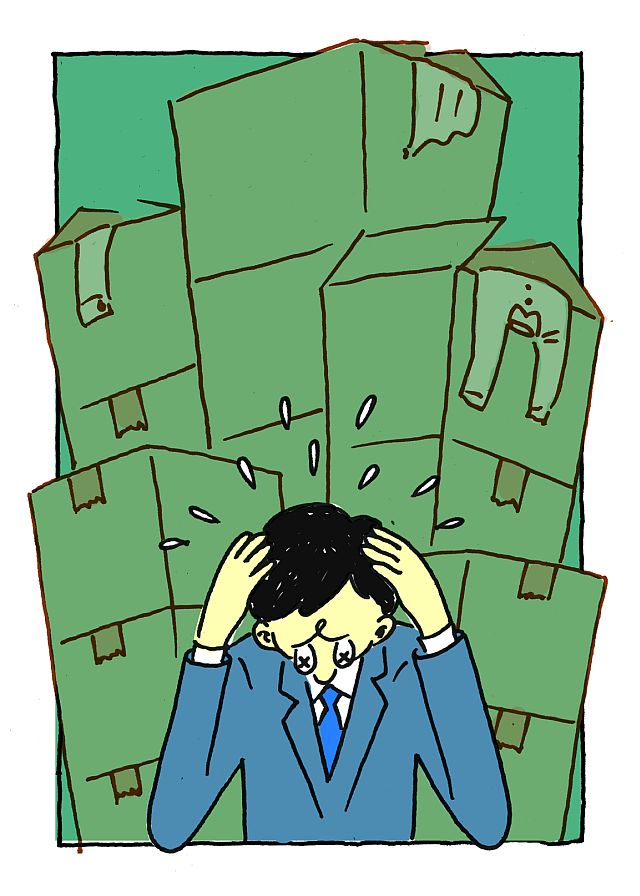Clothing has not been selling. Poor sales in the autumn and winter, especially in womenswear, are giving rise to growing despair. Many industry experts initially predicted that last April’s consumption tax increase from 5% to 8% would have a limited impact, however the “consumption tax shock” is lasting longer than expected.
Meanwhile, consumption patterns are changing. This is not simply bipolarisation; the reason being that sales have been slow, regardless of the price range and channel. As consumers become ever harder to discern, new studies are under way to gain a better understanding of their behaviour.
The collapse of existing norms
“The situation is truly tough,” an organizer of a S/S 15 innerwear fair for mass retailers said.“If sales at 80% of the list price year-on-year continue for three years, total sales will drop by more than 50%. I hope I’m worrying for nothing, but it is not an impossible scenario.”
Until recently, practical clothing, such as innerwear, was associated with relatively strong sales. However, the surge in demand ahead of the consumption tax hike largely exceeded industry expectations. Likewise, the consumption decline following the tax hike exceeded forecasts. The existing norm is beginning to no longer apply even to the consumption of low-priced practical clothing.
“It is becoming increasingly difficult to sell clothing [and] the consumption tax hike is not the only cause,” said a director of a mail order company.
This is because, along with the expansion of internet shopping, brick-and-mortar stores have also opened, including a series of mega shopping centres, SPAs (speciality stores of private label apparel), and fast-fashion outlets. “It is becoming possible to purchase similar products at low prices.” Despite rising costs due to the weakening yen, retailers have refrained from increasing the price ranges of products. Nonetheless, this has not stopped the declining customer trend.
Of the five major department stores, November 2014 sales were higher than the previous year for Isetan Mitsukoshi Holdings Ltd.; Takashimaya Company, Limited; Sogo & Seibu Co., Ltd.; and Hankyu Hanshin Department Stores, Inc. Considering, however, that this year included two more public holidays, which are the most profitable days, sales were actually lower than the previous year for most of the stores.
The biggest factor behind this was the slow sales of womenswear. This was particularly evident with coats. While sales were initially strong as “nice coats sell first”, the situation turned around during the real demand period. “Although we saw strong sales of high-priced products, sales of womenswear as a whole fell below last year’s, with low sales volume, especially nationwide brands” (Takashimaya).
“When the situation is this bad, major changes must be made to the company. Maybe the situation is presenting such an opportunity,” said an executive at a major apparel chain.said an executive at a major apparel chain.
Department stores’ womenswear sales showed signs of recovery in September. Since October, however, products in the upper price ranges have generally struggled, except for the leading brand, Sanyo Shoukai Ltd.
“For the core brands, the situation has been up and down” (Onward Holdings Co., Ltd.).In particular, the slump in down coats has hit sales hard. Despite cutting down supply from the previous year, “the sales outlook is more bleak than last year” (Sanyo Shoukai). In the lead-up to the winter sale season, retailers worry about consumers’ reluctance to buy.
Uncertain criteria
“The consumer mindset towards clothing purchases has changed,” noted Mitsuhiro Takeda, president of United Arrows Ltd., one of the leading speciality stores in Japan.
He said he keenly sensed the bipolarisation of purchasing patterns during S/S 14. “A product that an individual ‘wants’ and therefore has value to them sells well at any time. However, with products that an individual buys because he/she ‘needs’ it, it is becoming harder to establish a criteria for determining both the purchasing timing and quantity.”
A/W 14/15 sales were also slow for speciality stores. For this reason, some retailers have begun once again to revise their season merchandising schedules. Starting in S/S 15, United Arrows, which until now had six season classifications a year, will break down the seasons further, into eight classifications at most.
Baycrew’s Co. Ltd says “Instead of treating the four months in the summer and winter as the sale period and the remaining eight months as the proper sales period, we need to change the system into one that takes into account what customers want next and what proposals would please customers, even during the sale period.”
This is because “the system of going after strong sales during the season and selling what remains by holding sales is no longer applicable.” Consumers increasingly have a sharp eye for products, demanding innovations from the products’ suppliers.
Pages: 1 2

